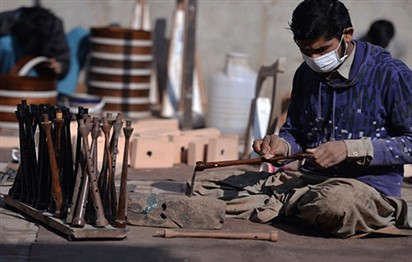Umer Farooq’s grandfather and father made bagpipes. Now he is the third generation to take up the tradition in Pakistan, which is thousands of kilometres from Scotland yet sells thousands of bagpipes each year.
Covered in sawdust, they carve the wood and polish it. Rosewood or ebony serve as the blowstick, into which players exhale. The drones — long pipes with a lower tone follow a similar process.
They are then attached to a bag, and often covered with tartan, a coloured plaid fabric typical of Scotland.
“In my family, all the boys know how to make a bagpipe, step by step,” said Farooq.
“When we were seven or eight, we would go to the factory. It was like a school, but the teachers were our dads and uncles.”
Honing such a craft is not easy.
South Asia has had for centuries its pungi, a wind instrument used for snake charming, and shehnai, a traditional oboe.
But the bagpipe had to wait until the mid-19th century for British colonialists to bring it to subcontinental India, of which Pakistan was a part before independence and partition in 1947.
Locals seized on the tradition, which remains popular till this day, with dozens of bagpipe bands available for weddings and religious festivals.
Proudly he shows pictures on his mobile phone of the band in colourful costumes.
Forrest says Pakistani bands put the emphasis on how they look, rather than musical technique, “which is less important to them”.
The Pakistani military, born out of the colonial British Indian Army, also still has a soft spot for the instrument.
In 2014 it established a camel-mounted bagpipe band attached to a unit of Desert Rangers. The camels, draped in scarlet and gold as their musicians sway above them, are particularly appreciated during parades.
But Pakistan’s main affiliation with bagpipes is its mass production of them, though the quality of the instruments it makes can vary.
Some 2,600 are exported from the Mid East factory each year, mainly to the United States.




